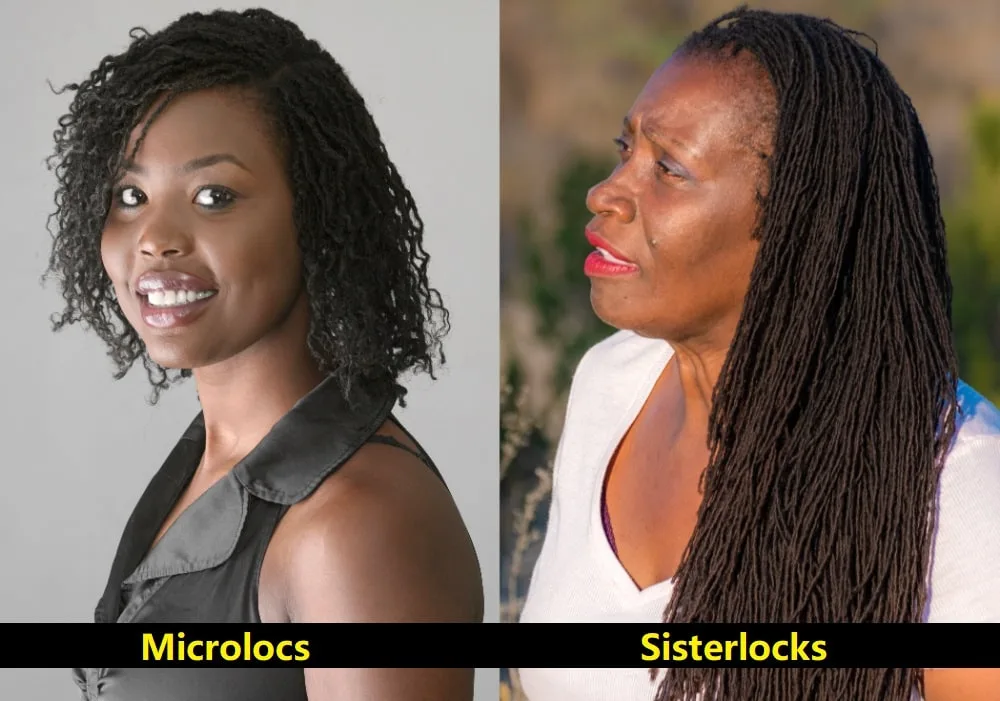Two popular methods of locking your hair are microlocs and sisterlocks. Both methods have unique benefits and drawbacks, so weigh all of your options and compare them.
Let’s help you decide which type is best for you with our microlocs vs sisterlocks guide so you can understand the differences and get started on your journey to gorgeous, healthy locs.
What Are Microlocs?

Microlocs are small, tight dreadlocks, usually less than half an inch in diameter. They work best on kinky or coily hair textures, then secured with a latch-crochet needle or interlocking technique.
Microlocs can also be started with braids, two-strand twists, coiling, or palm-rolling the hair. Each method can create different results, so consult with a professional before getting started.
Pros and Cons of Microlocs
Although microlocs can be a great way to achieve beautiful locs, there are also drawbacks.
Some pros are the following.
- Inexpensive to Maintain. When it’s time to re-tighten your locs, it is easy to do at home with no special tools or training, depending on the method used to install them.
- Installation Methods. Several methods are available for installing microlocs, depending on your preference and hair type, and you can even install them yourself.
- Inexpensive to Install. Because the process is simpler and doesn’t require as much time or any training, microlocs are less expensive to install.
However, there are also some cons as well.
- No Precise Installation Pattern. Microlocs don’t have precise guidelines for how to part the hair and install the locs, so the final result can be less uniform.
- Possible to Make Mistakes. Because no formal training is required to install microlocs, mistakes can cause uneven locs or breakage.
- May Unravel or Clump. Before microlocs have fully locked, they can unravel or clump together, which requires repair to avoid undesired results.
What Are Sisterlocks?

Sisterlocks is a locking system that uses a precise grid to section the hair and install the locs.
Sisterlocks involve sectioning the hair into small sections, then using a specialized tool to secure the section of hair with a proprietary locking method. The result is a series of extremely small, uniform locks.
Pros and Cons of Sisterlocks
Like microlocs, sisterlocks offer several benefits but also a few drawbacks. Here’s a look at some pros.
- Tight, Uniform Locks. Sisterlocks are tiny, uniform, and less likely to unravel or clump. Retention is typically better with sisterlocks as the re-tightening process is more precise.
- Formal Installation Process. Sisterlocks require a specialized tool and training, so the formalized installation process ensures correct installation.
- Style Versatility. Sisterlocks offers more options for wearing your hair and experimenting with different looks, and the precise locking pattern can make your hair appear fuller.
However, there are also some drawbacks.
- High Installation Cost. Sisterlocks can be expensive, and the cost can be higher if your loctitian has additional certification, such as being a Sisterlocks Brand Ambassador.
- Long Installation Time. Sisterlocks can take a long time to install, often over multiple days, depending on the length and density of your hair.
- High Maintenance. Sisterlocks require regular maintenance to keep them tidy and prevent buildup, which can be expensive and time-consuming.
What Do Microlocs and Sisterlocks Look Like?

While microlocs and sisterlocks have a lot in common and often look similar, there are a couple of differences in their appearance.
Sisterlocks have many more locs per square inch than microlocs, giving sisterlocks a much tighter, denser appearance. Usually, there is a minimum of 400 sisterlocks, whereas microlocs have at least 150.
While microlocs may look similar to sisterlocks when they are new, they increase in volume or become thicker as they age, making them heavier and more difficult to style. Sisterlocks maintain the same uniform size.
Key Differences Between Microlocs and Sisterlocks
Sisterlocks are often compared to microlocs, as both involve sectioning the hair into small sections and securing each section with a tool. However, there are some significant differences between the two.
The biggest difference between microlocs and sisterlocks is the cost. Microlocs usually start at $200, while sisterlocks cost a minimum of $500, depending on hair length and density and whether the loctitian is a trainee or certified consultant.
Another big difference is the time it takes to get each style. Microlocs usually takes around 8-20 hours to install, while sisterlocks can take up to 3 days.
A sisterlocks consultant will install a series of test locks before full installation. Test locks determine the best pattern to use for a client’s hair. The consultant will then install sisterlocks in the determined rows and columns.
|
Microlocs |
Sistelocks |
|
|
Cost of installation |
Low (starts $200) |
High (starts $500) |
|
Maintenance |
Easy to do at home |
Regular maintenance with a specialist |
|
Durability |
Need re-tightening around every six weeks |
Need re-tightening around every six weeks |
|
Installation time |
A few hours |
A few days |
Can You Turn Sisterlocks Into Microlocs?
Yes, you can turn sisterlocks into microlocs, but it’s not reversible. Ideally, once sisterlocks are mature, you can convert them into microlocs by combining two locs and interlocking them together or palm-rolling at the root.
So, Microlocs vs. Sisterlocks, Which One Is Better?
If you want a more affordable option with less commitment, then microlocs may be the way to go. But if you’re willing to invest time and money into a long-term style, then sisterlocks may be the better choice.
